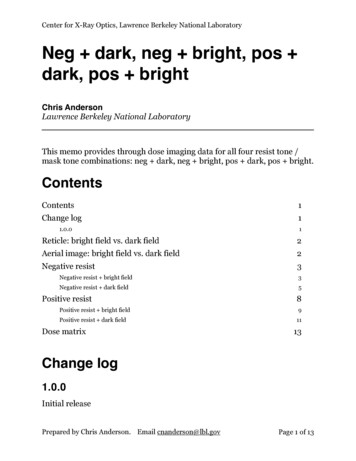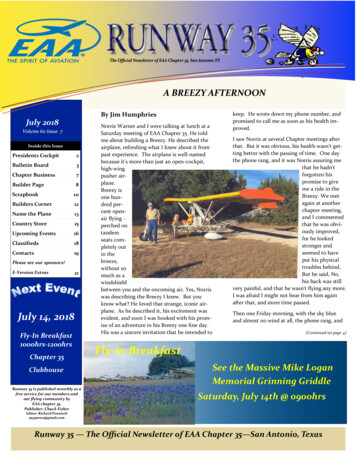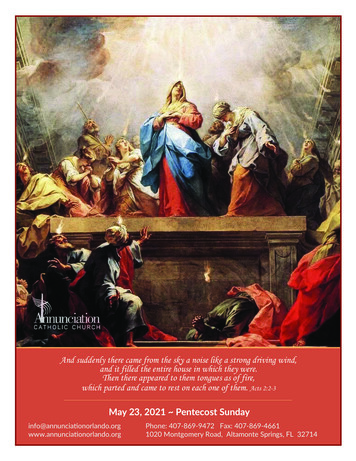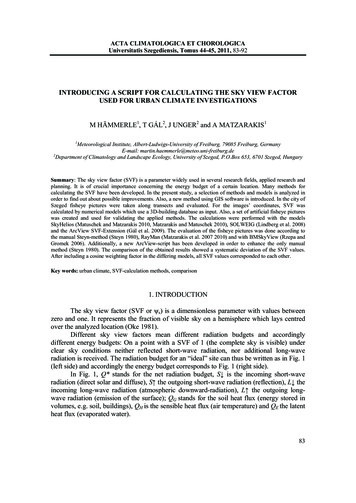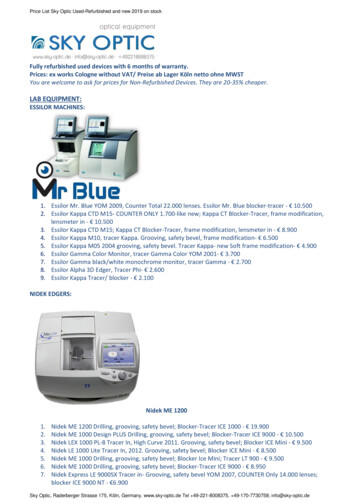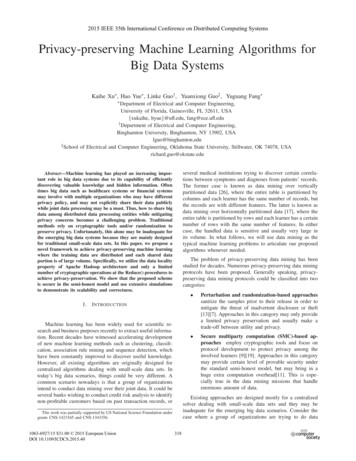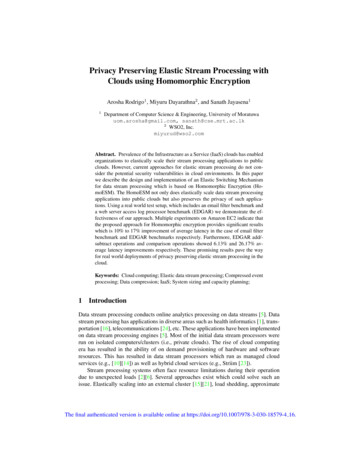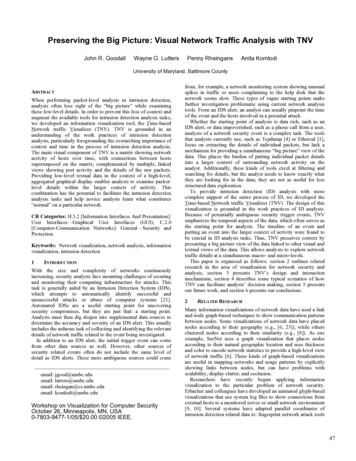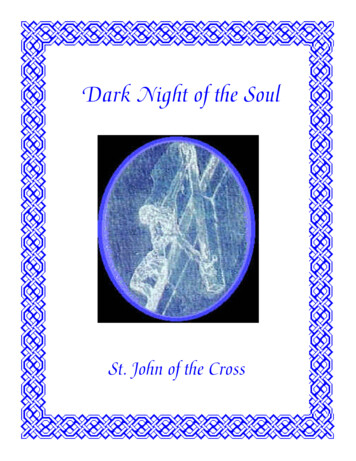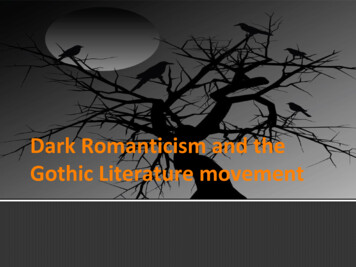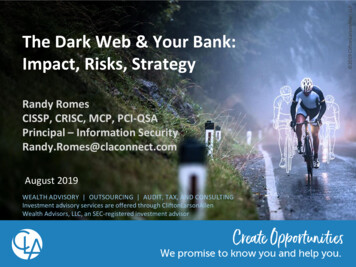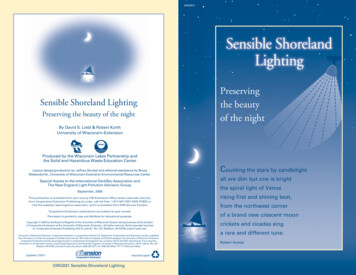
Transcription
GWQ031Sensible Shoreland LightingPreserving the beauty of the nightPreservingthe beautyof the nightBy David S. Liebl & Robert KorthUniversity of Wisconsin–ExtensionProduced by the Wisconsin Lakes Partnership andthe Solid and Hazardous Waste Education CenterLayout design/production by Jeffrey Strobel and editorial assistance by BruceWebendorfer, University of Wisconsin-Extension Environmental Resources Center.Special thanks to the International DarkSky Association andThe New England Light Pollution Advisory Group.September, 2000This publication is available from your county UW-Extension office (www.uwex.edu/ces/cty),from Cooperative Extension Publishing (to order, call toll-free: 1-877-947-7827 [WIS-PUBS] orvisit this website: learningstore.uwex.edu), and it is available from DNR Service Centers.Cooperative Extension publications are subject to peer review.Permission is granted to copy and distribute for educational purposes.Copyright 2000 by the Board of Regents of the University of Wisconsin System doing business as the divisionof Cooperative Extension of the University of Wisconsin-Extension. All rights reserved. Send copyright inquiriesto: Cooperative Extension Publishing, 432 N. Lake St., Rm. 227, Madison, WI 53706, pubs@uwex.edu.University of Wisconsin-Extension, Cooperative Extension, in cooperation with the U.S. Department of Agriculture and Wisconsin counties, publishesthis information to further the purpose of the May 8 and June 30, 1914, Acts of Congress. An EEO/AA employer, the University of Wisconsin-Extension,Cooperative Extension provides equal opportunities in employment and programming, including Title IX and ADA requirements. If you need thisinformation in an alternative format, contact Equal Opportunity and Diversity Programs, University of Wisconsin-Extension, 432 N. Lake St., Rm. 501,Madison, WI 53706, diversity@uwex.edu, phone: (608) 262-0277, fax: (608) 262-8404, TTY: 711 Wisconsin Relay.Updated 1/2013recycled paperGWQ031 Sensible Shoreland LightingCounting the stars by candlelightall are dim but one is brightthe spiral light of Venusrising first and shining best,from the northwest cornerof a brand new crescent mooncrickets and cicadas singa rare and different tune.Robert Hunter
Why Sensible Lighting MattersMany of us can remember sitting on a dock on acrystal clear summer night, the water as flat as glass,the inky black surface mirroring the sky, the greatwhite Milky Way, a falling star tracing a path acrossthe heavens.Unfortunately, this precious part of our heritage, theoutdoors with only the light of the moon and stars, isfading away. “Dusk to dawn” lights obscure our viewof constellations, meteor showers, planets, and thelandscape lit by the moon. Many children now see thewonders of the night sky only in pictures or atplanetariums. The fading away of the night sky is anissue not only in cities, but also in the countryside andin developing waterfront communities.As a 24-hour society concerned with safety, utility andsecurity, the United States wastes as much as onebillion dollars a year on lighting that provides neithersafety nor security, but simply lights the night sky andcreates an adverse effect on nocturnal creatures andmigrating birds. But it doesn’t have to be this way.Most glare and sky glow is unnecessary. The light thattemporarily blinds us or obscures our view of the nightsky comes mainly from poorly designed and inefficientlighting fixtures.This booklet discusses the issue of light pollution,with a special focus on issues surrounding shorelandlighting. You will find information on new lightingtechnologies that can deliver adequate illumination,provide security, save money and reduce light pollutionwithout competing with the beauty of the night.2Cover lyric from Terrapin StationNine Publishing CompanyUsed with permission IceEliminating glare and light pollution saves money whilereducing our impact upon neighbors and creatures of thenight. The stars above us are a priceless heritage, not only forscientific knowledge, but also for our identity as human beings.David Crawford, Executive Director of the International DarkSky Association says: “Light pollution is not a matter of lifeand death. Yet it is important nonetheless, profoundly so.We human beings lose something of ourselves when we canno longer look up and see our place in the universe. It is likenever again hearing the laughter of children; we give up partof what we are.”Sources of Sensible Lighting Equipment:(Reference to commercial products or businesses in this publication do notconstitute an endorsement by the University of Wisconsin–Extension.)This is a selective list. Other local sources may be available.Dock and Marina LightingSources of Additional InformationEaton Corporation,Marina Power and Lighting149 Warwick CourtWilliamsburg, VA comThe Model WisconsinExterior Lighting CodeSolid and Hazardous WasteEducation Center (SHWEC)(608-265-2360)Residential and CommercialLightingHubbell Lighting, Inc.710 Millennium BlvdGreenville, SC ional Dark-SkyAssociation (IDA)www.darksky.orgThe Illuminating EngineeringSociety of North Americawww.iesna.orgKim Lighting16555 East Gale Ave.City of Industry, CA 91745(626-978-5666)www.kimlighting.comThomas Lighting1600 Fleetwood Dr.Elgin, IL 60123(800-825-5844)www.thomaslighting.comRuud Lighting Direct(800-236-7000)www.ruudlightingdirect.com11
Local Regulations to Improve LightingShoreland Lighting: A Special ConcernMunicipalities in a number of states have enacted lightingcontrol ordinances. These measures prohibit inefficient,low-quality lighting. Lake and homeowner associations ormunicipalities interested in regulating shoreland lighting cantake example from the following section of the Oneida County,Wisconsin zoning code, which focuses on pier lighting:The rising cost of waterfront property in Wisconsin providesample evidence of the importance of the shoreland environmentto the people that live along it. During the daytime thisenvironment is heavily used for recreation. Artificial lightingallows us to engage in nighttime activities that would beimpossible or unsafe under normal nighttime conditions.Whether it’s boating, fishing or simply sitting on the porch toread, our enjoyment of the night is enhanced by the use ofartificial light. At the same time, our rivers and lakes at nightprovide a quiet open dark space that gives us privacy and anopportunity to enjoy the heavens. Balancing the ability to seeat night with the desire to preserve the beauty of the night isthe goal of sensible shoreland lighting.Oneida County – Regulation of LightingThe purpose of this section is to minimize light pollutionof the shore land environment without significantly inhibitingsafety and security. This section applies to all lighting onberthing structures or designed to illuminate those structuresassociated with berths.Light fixtures which do not conform to these provisions maybe allowed with a conditional use permit upon a showing ofspecial circumstances affecting safety, security, or generalpublic interest. Non-conforming lighting in existence on theeffective date of this section must be brought into compliancewithin five (5) years.MinneapolisMadisonGreen BayMilwaukee1 Flashing and rotating lights are prohibited.2 Lighting inside a boathouse and intended to illuminate itsinterior is permitted.Chicago3 Lighting on exteriors of berthing structures shall be fittedwith opaque shields to prevent direct visibility of the lampto persons on public waters or adjacent lands more than50 feet beyond the berthing structure.Wasted lighting:Light escaping into thenight sky is shown inthis satellite photo ofthe Midwest.4 Lighting not mounted on a berthing structure but designedto illuminate a berthing structure or its immediate vicinityshall comply with subparagraph 3 above.5 Lighting installed on, or intended to illuminate, seasonallyused berthing structures shall be turned off when notrequired for safety or security.6 Public marinas may install illuminated signs with opaqueshaded or shielded lighting that provide informationpertaining to applicable federal state or municipal rulesand regulations relating to electrical, fueling, waste andsewage disposal or other safety and environmentalmatters. Such sign illumination shall not be visible off theberth structure.See the International Dark Sky Association web site for a comprehensive list of state/local ordinances (www.darksky.org).10Our Adaptable EyesWe use artificial lighting to be able to see our way in darkness.While this seems like an obvious statement, it is not really assimple as that. Our eyes can adjust themselves to a widerange of light levels. However, shifting from the bright to darkoperating range of the eye is not instantaneous. Our eyes canrequire 60 minutes or longer to fully adapt to darkness, whichis why we squint when walking from darkness into bright light,or pause to let our eyes adjust when stepping out into thenight. Once adapted, though, our eyes are sensitive enough tosee a single candle 10 miles away.3
Sensible LightingLighting and Your NeighborsSensible lighting can minimize the three most seriousproblems along our shorelands:Solving shoreland lighting problems always involves workingwith our neighbors. You may have spent some time workingon this problem, others may not have thought about it at all.An easy first step to educating our neighbors and ourselvesabout a perceived lighting problem is to identify all the sourcesof glare along the shoreland. A shoreland lighting survey caninventory problem lights and provide a basis for discussion.Glare: The first principle of good lighting is to illuminateonly what we wish to see. When we see a distant point of lightacross the water, when we are seeing light from the fixtureitself rather than what the fixture is meant to illuminate, weare observing glare. Poorly designed or poorly installedlighting causes glare that can severely hamper the vision ofboaters, pedestrians, cyclists, and drivers, creating a hazardrather than increasing safety.Light Trespass: Glare is also the most common cause of lighttrespass. Light trespass is a light fixture on one property thatilluminates an adjacent or nearby property. Light trespass isnot a legal concept, but rather a description of the nuisanceeffect of improperly aimed lights on someone else’s property.We all have seen streetlights, commercial lights or residentiallights spilling over onto adjacent property, causing illuminationwhere it was not meant to be. Poorly designed outdoorlighting shines onto neighborhood properties and bedroomwindows, invading privacy and creating an unattractive lookto an area. Because the waterfront is unobstructed, waterreflects glare from shoreland lights over the water to trespasson distant properties.Sky Glow: Much of our exterior lighting shines directlyupward, causing the sky above our cities to glow and washingout our view of the dark night sky. Billboard lights that shineupward, street lights that bounce light off pavement, andcommercial and residential lighting open to the sky allcontribute to sky glow. Today, only the most remote areas inour country are free from sky glow. We all have had theexperience of traveling from an urban to a rural environmentand marveling at the appearance of millions of stars in thenight sky. Unfortunately, it’s not uncommon for someoneraised in a major city to see the Milky Way for the first timeas an adult while vacationing in the countryside.4To conduct a shoreland lighting survey you will need to getout on the water at night, using a map to mark sources of lightfrom both near and far shorelands. On a small lake this mightmean circumnavigation, while on a large body of water notingthe compass coordinates of a light or marking its relation tolandmarks may be necessary. Then, during the daytime, try toidentify the specific light fixture that was the cause of the glare,taking care not to attribute a light to the wrong property.A shoreland lighting survey is an excellent project toundertake with your lake association or homeowners group.Making this a group project will make it easier for you toapproach your neighbors about improving their lights. Useyour lake association or neighborhood organization newsletteras a way to raise the issue and publicize the results of yoursurvey. You’ll be surprised how many people share yourconcern about night lighting.If you are talking individually to a neighbor about a lightingproblem, a careful explanation may be all that’s needed. Keepin mind that your neighbor probably has concerns about theirsafety and security and feels that their bright light is a goodsolution to their concerns. Above all, be tactful and courteous.Understand some of the facts about different lighting fixtures,energy savings, and the differences between a good securitylight and a light that is just very bright. Most people like to behelpful and cooperative when approached in a friendly andcooperative manner.9
Modifying Existing FixturesFLOODLIGHTChange this To this Aim DOWNWARDunshieldedlightWaterfront lighting is often used to identify a pier or marinafor boaters on the water after dark. Taverns and restaurantsuse neon signs to attract customers off the water. Dams andother structures uselights to warn ofdangers to navigation.Mills, factories, ballfields and otherfacilities near the wateralso light the shoreland.While these uses ofartificial lighting arelegitimate, we mustalso take into consideration those peoplewho can see thoselights, but are notusing them.WALLPACKChange this To this Install VISORFLOODLIGHTTo this OPAQUEREFLECTOROr this SHOEBOXArtwork courtesy of the New England Light Pollution Advisory GroupPhotos courtesy of McDonald ObservatoryChange this Good Lighting PaysDifferent kinds of lights provide different amounts of lightusing different amounts of electricity. Shopping around f
Ruud Lighting Direct (800-236-7000) www.ruudlightingdirect.com Sources of Sensible Lighting Equipment: Sources of Additional Information The Model Wisconsin Exterior Lighting Code Solid and Hazardous Waste Education Center (SHWEC) (608-265-2360) International Dark-Sky Association (IDA) www.darksky.org The Illuminating Engineering Society of North America www.iesna.org (Reference to
